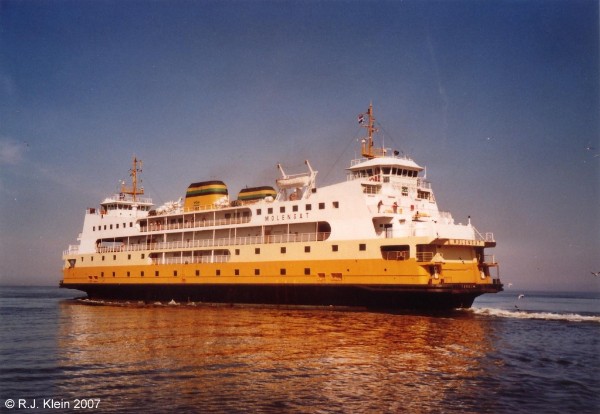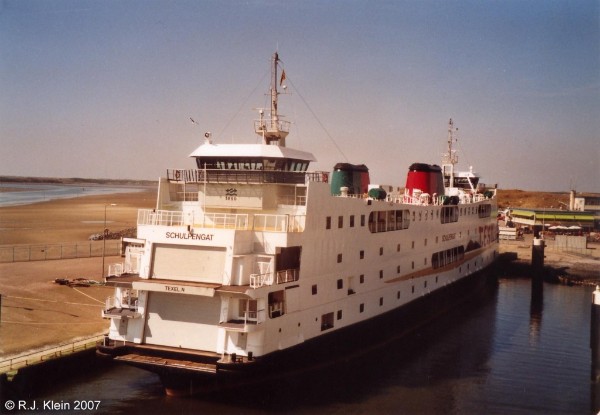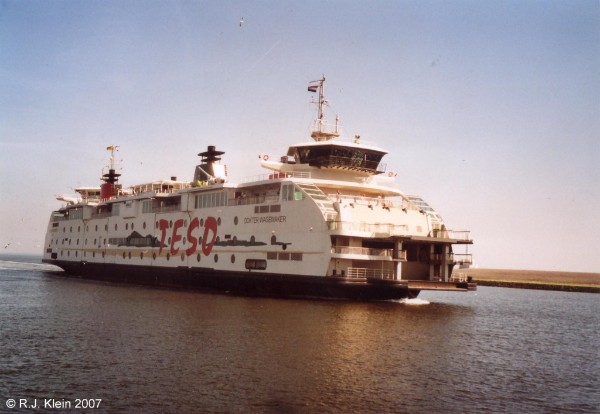TESO
In 1907, Texels Eigen Stoomboot Onderneming (TESO) was formed. It runs the services between the port of Den Helder in the north of Holland to the harbour of Texel at Het Horntje. Texel is a small island in the Waddenzee, a sea very spectacular because in dries up every day in tidal changes. Another company that runs services at the Waddenzee is Rederij Doeksen, connecting Harlingen in the province of Friesland to Terschelling and Vlieland. At these dry times, you can walk to some of the islands instead of taking the ferry, a day long walking journey called 'Wadlopen' or Wad Walking. This is a very popular way of holiday-making in the Netherlands.
The capital for the new TESO company was brought together by the islands doctor at the time, who's name was Adriaan Wagemaker. In English, the name of the company would be translated as Texels Own Steamship Company. Within the name, you can hear where it stands for. The company was created because the people living at Texel were very displeased by the service at that time, operated by the Alkmaar Packet Company of mister C. Bosman of Alkmaar. Their ships were old, made of wood, very expensive and the sailings were irregular and far between. So when doctor Adriaan Wagemaker collected the capital, many people from the island joined his idea and put money forward to set up their own company. Today, the company is still owned by the people who live on the island of Texel.
In 1909, the company won over the contract and Bosman sold its Alkmaar Packet service to TESO. Since then, the TESO runs the route alone. Especially after the second worldwar, tourism became a very important part for the growth of TESO. The company ordered bigger ships to cope with the growth in traffic. Also, cartraffic became more important so in the beginning of the 1950's the flagship Dokter Wagemaker, named after the doctor who founded the company, was lenghtened with five meters to accomodate more cars and passengers. But this was not enough, so a new ferry was brought into service, the Dageraad and this ship could ferry 30 cars at every sailing.

In the beginning of the 1960's, a big discussion started when the traditional port of Oudeschild, a small seaside village, would be replaced by a modern port to accomodate the planned larger ships of the company. This port was planned at the very southern tip of the island at Het Horntje. Here, several dunes had to be dug out and also the road network on the island had to be changed drasticly. But the main problem was, that many people, especially the people at Oudeschild, thought this would be an economical blow to the little town. But, it was decided that Het Horntje had to be the new port so work started and the first ships started to use the new port in 1962. A big plus for the use of this port would be, that the ships would loose half an hour sailing time and this was, because of the expected growth, very important because more sailing could be offered.

This growth came, because the island became more popular for the people of Holland. Especially in summer, when the holidays are at a peak, it became very crowded. So crowded, that waiting times in Den Helder for the ferry could be as high as eight hours and parking spaces were only limited. Next to this, it was very frustrating for the people who had to wait and the name of Texel as a holiday island was at stake. After all, tourism is the main source of income for the island so the importance of a good service is great. Next to that, for the people who live on the island, these waiting times were extra frustrating and extremely inconvenient. Because sailing with three ships was not possible due to logistic limits, the director of the company, Theo Hoogerheide, came with the wildly discussed solution to build double-deck ferries in the late 1970's. These ferries could sail with three times as many cars as the ferries then sailing. It was a great solution, but some people at Texel were sceptic about the fact that the small island would be flooded with tourists when this capacity was available. There even were true demonstrations organized, something the small community was not used to at all. But this double-deck ferry was built eventually, named Molengat and starting her services in 1980. The ship is shown on the first picture on this page, still painted in the original TESO-coloursceme. Although the ship started sailing in 1980, because of the complaints and coartcases that were put up against these double-decks, the new facilities that had to be built on shore were only opened in 1986. When in 1990 the new Schulpengat was introduced, the company had two double-deck ferries sailing and waiting times were reduced rapidly. Schulpengat is pictured in the middle of this page, in the new coloursceme that was introduced at the new Dokter Wagemaker, but only applied to Schulpengat in 2007.

In 2004, the company introduced a giant ferry, way bigger then any ship that sailed the Waddenzee. Also a double-deck ferry, the thirth Dokter Wagemaker introduced a new coloursceme to the route. The ship was built also with the growth of the cars itself in mind so the cardecks are very spacious. The ferry is measured just over 17.000. That is the same measurement as the cruiseship MSC Rhapsody, for example. The ship can accomodate 1750 passengers and 300 cars, a great increase in passengercapacity from the earlier vessels. Some people again were not happy with her introduction, because of the enormous amount of tourists that would be attracted by this new ship. Many thought she would be far too huge for the crossing, that just takes 20 minutes. When she was introduced, Molengat was put up for sale and used as an extra vessel for the route untill she was finally sold to the Indian company Halani Shipping in 2007 where she now sails under the name of Halani-1. She now is in service as a diving supportship in the Persian Gulf near the United Arab Emirates. Also in 2007, at the 100-year centenary the company was declared 'Royal', so the new Dutch name became Koninklijke NV Texels Eigen Stoomboot Onderneming.
TESO is planning to replace the Schulpengat by a very modern ferry in 2016. This new ship has to sail in conjunction with the Dokter Wagemaker, With these two ships, TESO will operate the most modern ferryservice of the Waddenzee. Recently announced, the name of this new ship will be Texelstroom. This name was chosen out of a very bunch of names that could be sent in to TESO as public suggestions. Of course, I also sent in a name, but sadly it's not this one... In design, the new ship will be based on the Dokter Wagemaker, but she will be updated with the most modern environmental-friendly technologies, making her the most advanced ship sailing the Dutch inland waterways and probably one of the most modern and innovative ferries at the European continent.

